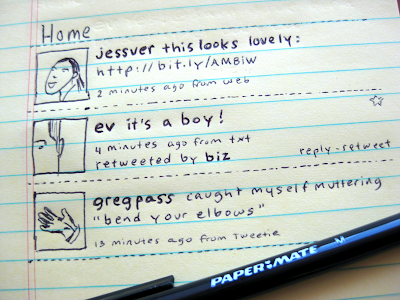It's been a few days since Google launched its nascent social network, Google+. I've spent…
Twitter Adds Retweet Function – And What It Means
Twitter’s new retweet function is finally rolling out. Twitter co-founder Biz Stone first revealed the project on the TwitterBlog back in August. I noticed it available in beta on the various accounts I manage this week. Ev Williams, the other guy behind Twitter, took to his blog yesterday to explain the new feature a bit more.
A retweet on Twitter occurs when someone wants to pass along a message originated by someone else. The easiest way to do this (in the past) was to just add “RT” to the beginning of the original tweet along with the original tweeter’s username. Doing it this way ensured proper attribution for the original thought or message. Third-party apps like TweetDeck made it even easier with a “retweet” button which automatically populated the “RT @username” portion of the message.
An example of a reason to retweet – I manage the Twitter account for a local children’s activities website. While we tweet original messages and links, we also retweet other messages and links that we believe our followers would find relevant. Like, if our local arena announces dates for Sesame Street Live on Twitter, we retweet that message to our followers – many of whom probably do not follow the arena on Twitter – but now they have the information via the retweet.
Now, Twitter is changing the retweet game a bit (although users can still retweet the old school way if they choose).
Biz’s original explanation:
Let’s say you follow @jessverr, @biz (that’s me), and @gregpass but you don’t follow @ev. However, I do follow @ev and the birth of his baby boy was so momentous that I retweeted it to all my followers.
Imagine that my simple sketch is your Twitter timeline. You’d see @ev‘s tweet even though you don’t follow him because you follow me and I really wanted you to have the information that I have. (The star, reply, and retweet options only show up when you hover over a row on Twitter.com which is why you don’t see them all the time.) Also, if you find my retweets annoying, then you’ll be able to turn them off.
Now Ev has chimed in on the reasons behind the change. He says the reasons are:
- Attribution confusion- people get confused as to who originated the message
- Messiness – people often edit retweets to fit into 140 characters and they include different types of attriubtions – ultimately, they can get hard to read
- Redundancy – users often receive multiple retweets of the same message from different people they follow
- Noisiness – some users retweet EVERYTHING and it gets a bit annoying
- Untrackable – sometimes (often) the number of times something retweeted is important and something to be measured
Ev says:
There’s a retweet link by each tweet and, with two clicks, it will be sent on to your followers. This takes care of the mangled and messy problem because no one gets an opportunity to edit the tweet (more on that below). The meta data (about who tweeted and who retweeted) is not in the tweet text itself, so they never have to be edited for length. Because they’re built natively into the system, they’re trackable. And because they’re trackable, we can take care of the redundancy problem: You will only get the first copy of something retweeted multiple times by people you follow.
It will be very quick and easy to retweet, you’ll never have to edit the text, and you also won’t have to worry if your followers have already seen something, so this should encourage retweeting more and more useful stuff flowing farther.
The noisiness problem is taken care of by a new setting that will allow you to turn on and off retweets on a per-user basis. That is, if you only want to see someone’s personally authored tweets, you can shut off just their retweets altogether but still follow them.
The attribution problem: In order to get rid of the attribution confusion, in your timeline we show the avatar and username of the original author of the tweet—with the person who retweeted it (whom you actually follow) in the metadata underneath. The decision is that this:
…is a better presentation than this:
The one major drawback I see to the new system is that it is not (currently) possible to add your own comment to a retweet – which I often do. But, as I mentioned before, we still have the option to use the old method as well.
There will be a learning curve and probably some whining and shouting as people get used to this – we’ll have to wait and see how it all pans out. What do you think?


